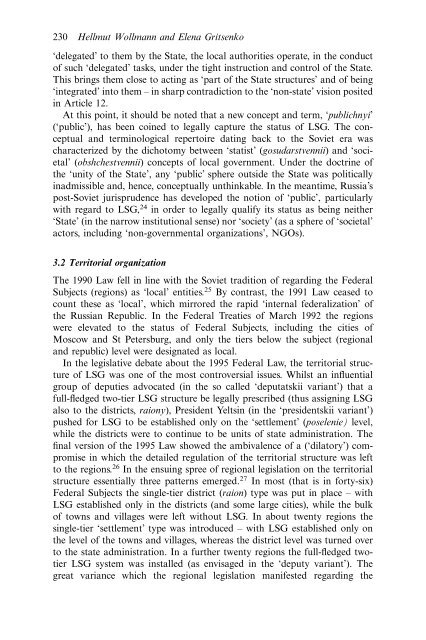Federalism and Local Politics in Russia
Federalism and Local Politics in Russia
Federalism and Local Politics in Russia
You also want an ePaper? Increase the reach of your titles
YUMPU automatically turns print PDFs into web optimized ePapers that Google loves.
230 Hellmut Wollmann <strong>and</strong> Elena Gritsenko‘delegated’ to them by the State, the local authorities operate, <strong>in</strong> the conductof such ‘delegated’ tasks, under the tight <strong>in</strong>struction <strong>and</strong> control of the State.This br<strong>in</strong>gs them close to act<strong>in</strong>g as ‘part of the State structures’ <strong>and</strong> of be<strong>in</strong>g‘<strong>in</strong>tegrated’ <strong>in</strong>to them – <strong>in</strong> sharp contradiction to the ‘non-state’ vision posited<strong>in</strong> Article 12.At this po<strong>in</strong>t, it should be noted that a new concept <strong>and</strong> term, ‘publichnyi’(‘public’), has been co<strong>in</strong>ed to legally capture the status of LSG. The conceptual<strong>and</strong> term<strong>in</strong>ological repertoire dat<strong>in</strong>g back to the Soviet era wascharacterized by the dichotomy between ‘statist’ (gosudarstvennii) <strong>and</strong> ‘societal’(obshchestvennii) concepts of local government. Under the doctr<strong>in</strong>e ofthe ‘unity of the State’, any‘public’ sphere outside the State was politically<strong>in</strong>admissible <strong>and</strong>, hence, conceptually unth<strong>in</strong>kable. In the meantime, <strong>Russia</strong>’spost-Soviet jurisprudence has developed the notion of ‘public’, particularlywith regard to LSG, 24 <strong>in</strong> order to legally qualify its status as be<strong>in</strong>g neither‘State’ (<strong>in</strong> the narrow <strong>in</strong>stitutional sense) nor ‘society’ (as a sphere of ‘societal’actors, <strong>in</strong>clud<strong>in</strong>g ‘non-governmental organizations’, NGOs).3.2 Territorial organizationThe 1990 Law fell <strong>in</strong> l<strong>in</strong>e with the Soviet tradition of regard<strong>in</strong>g the FederalSubjects (regions) as ‘local’ entities. 25 By contrast, the 1991 Law ceased tocount these as ‘local’, which mirrored the rapid ‘<strong>in</strong>ternal federalization’ ofthe <strong>Russia</strong>n Republic. In the Federal Treaties of March 1992 the regionswere elevated to the status of Federal Subjects, <strong>in</strong>clud<strong>in</strong>g the cities ofMoscow <strong>and</strong> St Petersburg, <strong>and</strong> only the tiers below the subject (regional<strong>and</strong> republic) level were designated as local.In the legislative debate about the 1995 Federal Law, the territorial structureof LSG was one of the most controversial issues. Whilst an <strong>in</strong>fluentialgroup of deputies advocated (<strong>in</strong> the so called ‘deputatskii variant’) that afull-fledged two-tier LSG structure be legally prescribed (thus assign<strong>in</strong>g LSGalso to the districts, raiony), President Yelts<strong>in</strong> (<strong>in</strong> the ‘presidentskii variant’)pushed for LSG to be established only on the ‘settlement’ (poselenie) level,while the districts were to cont<strong>in</strong>ue to be units of state adm<strong>in</strong>istration. Thef<strong>in</strong>al version of the 1995 Law showed the ambivalence of a (‘dilatory’) compromise<strong>in</strong> which the detailed regulation of the territorial structure was leftto the regions. 26 In the ensu<strong>in</strong>g spree of regional legislation on the territorialstructure essentially three patterns emerged. 27 In most (that is <strong>in</strong> forty-six)Federal Subjects the s<strong>in</strong>gle-tier district (raion) type was put <strong>in</strong> place – withLSG established only <strong>in</strong> the districts (<strong>and</strong> some large cities), while the bulkof towns <strong>and</strong> villages were left without LSG. In about twenty regions thes<strong>in</strong>gle-tier ‘settlement’ type was <strong>in</strong>troduced – with LSG established only onthe level of the towns <strong>and</strong> villages, whereas the district level was turned overto the state adm<strong>in</strong>istration. In a further twenty regions the full-fledged twotierLSG system was <strong>in</strong>stalled (as envisaged <strong>in</strong> the ‘deputy variant’). Thegreat variance which the regional legislation manifested regard<strong>in</strong>g the
















